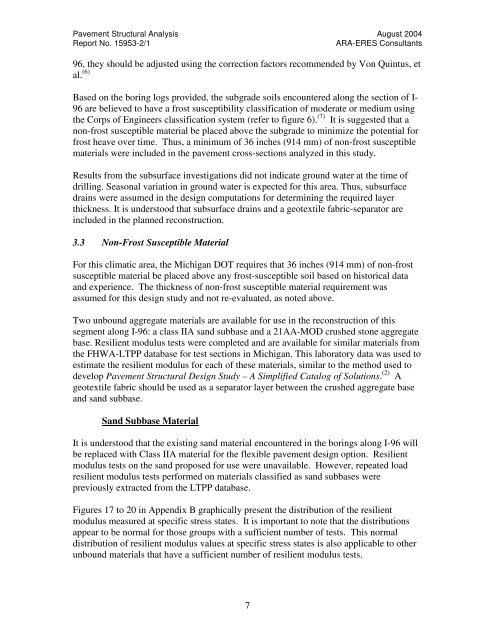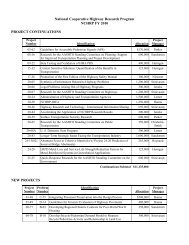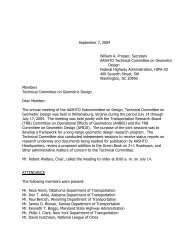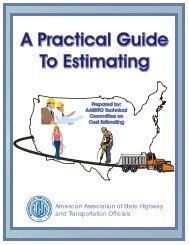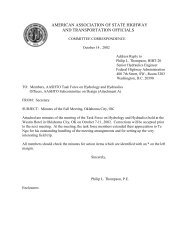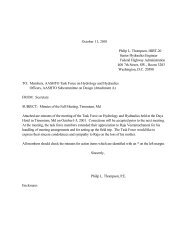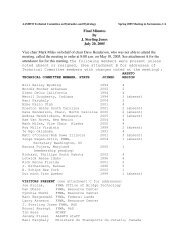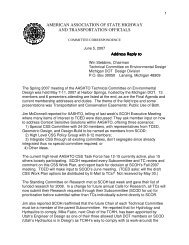Pavement Structural Analysis of the Design Recommendations for ...
Pavement Structural Analysis of the Design Recommendations for ...
Pavement Structural Analysis of the Design Recommendations for ...
Create successful ePaper yourself
Turn your PDF publications into a flip-book with our unique Google optimized e-Paper software.
<strong>Pavement</strong> <strong>Structural</strong> <strong>Analysis</strong> August 2004<br />
Report No. 15953-2/1 ARA-ERES Consultants<br />
96, <strong>the</strong>y should be adjusted using <strong>the</strong> correction factors recommended by Von Quintus, et<br />
al. (6)<br />
Based on <strong>the</strong> boring logs provided, <strong>the</strong> subgrade soils encountered along <strong>the</strong> section <strong>of</strong> I-<br />
96 are believed to have a frost susceptibility classification <strong>of</strong> moderate or medium using<br />
<strong>the</strong> Corps <strong>of</strong> Engineers classification system (refer to figure 6). (7) It is suggested that a<br />
non-frost susceptible material be placed above <strong>the</strong> subgrade to minimize <strong>the</strong> potential <strong>for</strong><br />
frost heave over time. Thus, a minimum <strong>of</strong> 36 inches (914 mm) <strong>of</strong> non-frost susceptible<br />
materials were included in <strong>the</strong> pavement cross-sections analyzed in this study.<br />
Results from <strong>the</strong> subsurface investigations did not indicate ground water at <strong>the</strong> time <strong>of</strong><br />
drilling. Seasonal variation in ground water is expected <strong>for</strong> this area. Thus, subsurface<br />
drains were assumed in <strong>the</strong> design computations <strong>for</strong> determining <strong>the</strong> required layer<br />
thickness. It is understood that subsurface drains and a geotextile fabric-separator are<br />
included in <strong>the</strong> planned reconstruction.<br />
3.3 Non-Frost Susceptible Material<br />
For this climatic area, <strong>the</strong> Michigan DOT requires that 36 inches (914 mm) <strong>of</strong> non-frost<br />
susceptible material be placed above any frost-susceptible soil based on historical data<br />
and experience. The thickness <strong>of</strong> non-frost susceptible material requirement was<br />
assumed <strong>for</strong> this design study and not re-evaluated, as noted above.<br />
Two unbound aggregate materials are available <strong>for</strong> use in <strong>the</strong> reconstruction <strong>of</strong> this<br />
segment along I-96: a class IIA sand subbase and a 21AA-MOD crushed stone aggregate<br />
base. Resilient modulus tests were completed and are available <strong>for</strong> similar materials from<br />
<strong>the</strong> FHWA-LTPP database <strong>for</strong> test sections in Michigan. This laboratory data was used to<br />
estimate <strong>the</strong> resilient modulus <strong>for</strong> each <strong>of</strong> <strong>the</strong>se materials, similar to <strong>the</strong> method used to<br />
develop <strong>Pavement</strong> <strong>Structural</strong> <strong>Design</strong> Study – A Simplified Catalog <strong>of</strong> Solutions. (2) A<br />
geotextile fabric should be used as a separator layer between <strong>the</strong> crushed aggregate base<br />
and sand subbase.<br />
Sand Subbase Material<br />
It is understood that <strong>the</strong> existing sand material encountered in <strong>the</strong> borings along I-96 will<br />
be replaced with Class IIA material <strong>for</strong> <strong>the</strong> flexible pavement design option. Resilient<br />
modulus tests on <strong>the</strong> sand proposed <strong>for</strong> use were unavailable. However, repeated load<br />
resilient modulus tests per<strong>for</strong>med on materials classified as sand subbases were<br />
previously extracted from <strong>the</strong> LTPP database.<br />
Figures 17 to 20 in Appendix B graphically present <strong>the</strong> distribution <strong>of</strong> <strong>the</strong> resilient<br />
modulus measured at specific stress states. It is important to note that <strong>the</strong> distributions<br />
appear to be normal <strong>for</strong> those groups with a sufficient number <strong>of</strong> tests. This normal<br />
distribution <strong>of</strong> resilient modulus values at specific stress states is also applicable to o<strong>the</strong>r<br />
unbound materials that have a sufficient number <strong>of</strong> resilient modulus tests.<br />
7


